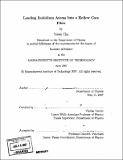| dc.contributor.advisor | Vladan Vulteić. | en_US |
| dc.contributor.author | Chu, Yiwen | en_US |
| dc.contributor.other | Massachusetts Institute of Technology. Dept. of Physics. | en_US |
| dc.date.accessioned | 2008-03-27T18:21:41Z | |
| dc.date.available | 2008-03-27T18:21:41Z | |
| dc.date.copyright | 2007 | en_US |
| dc.date.issued | 2007 | en_US |
| dc.identifier.uri | http://hdl.handle.net/1721.1/40904 | |
| dc.description | Thesis (S.B.)--Massachusetts Institute of Technology, Dept. of Physics, 2007. | en_US |
| dc.description | Includes bibliographical references (p. 71-73). | en_US |
| dc.description.abstract | We demonstrate a procedure for cooling, trapping, and transferring rubidium atoms into a hollow core photonic band gap fiber. The atoms are first collected in a magneto-optical trap (MOT) and then cooled using polarization gradient cooling. Magnetic traps are then used to confine and transfer the atoms toward the face of the fiber. An optical dipole trap formed using laser light propagating through the fiber guide the atoms and confine them away from the fiber walls. We hope to use this system to achieve large optical depths with possible applications to quantum computing. | en_US |
| dc.description.statementofresponsibility | by Yiwen Chu. | en_US |
| dc.format.extent | 73 p. | en_US |
| dc.language.iso | eng | en_US |
| dc.publisher | Massachusetts Institute of Technology | en_US |
| dc.rights | M.I.T. theses are protected by
copyright. They may be viewed from this source for any purpose, but
reproduction or distribution in any format is prohibited without written
permission. See provided URL for inquiries about permission. | en_US |
| dc.rights.uri | http://dspace.mit.edu/handle/1721.1/7582 | en_US |
| dc.subject | Physics. | en_US |
| dc.title | Loading rubidium atoms into a hollow core fiber | en_US |
| dc.type | Thesis | en_US |
| dc.description.degree | S.B. | en_US |
| dc.contributor.department | Massachusetts Institute of Technology. Department of Physics | |
| dc.identifier.oclc | 212374628 | en_US |
